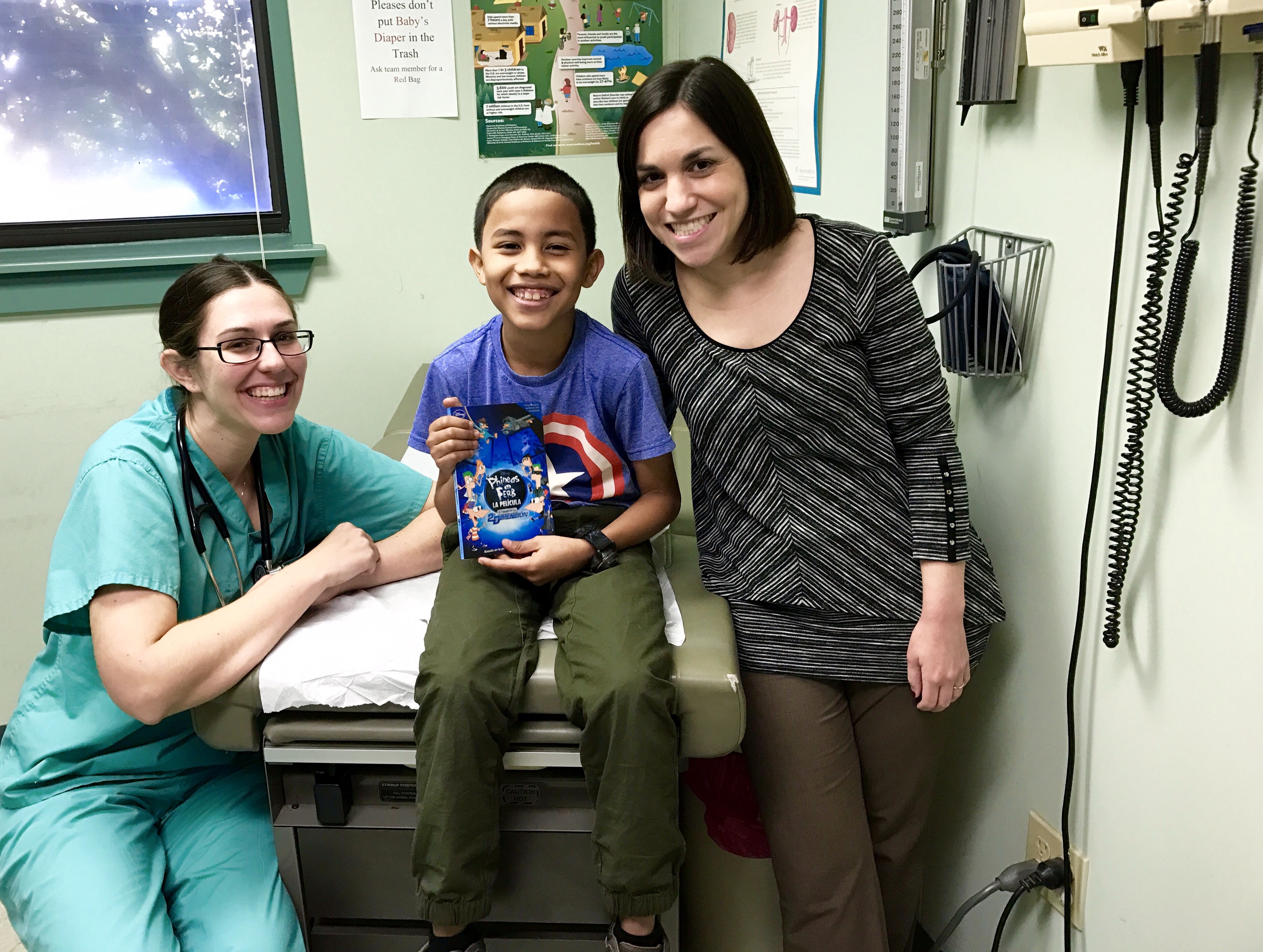“They put me in a cage.”
Children have a unique perspective on life. Their naive yet curious outlook on the world around them is expressed in raw and concrete truths. This week in our clinic, a young boy came to see us for his first visit ever to a doctor’s office. He was eager to tell his story and quickly felt comfortable with our staff. Immediately, his story began spilling out, unprovoked. “Doctor! They put me in a cage!” So affected by his recent experience of fleeing his homeland and seeking refuge in the United States, this sweet boy began telling his story in the only way he knew: through the unfiltered, raw images that were still so fresh in his mind.
The cage he referred to was indeed just that, and in fact is his first memory of the United States. This is how he vividly described the US Customs and Border Control processing facility. His story is not unlike many we have heard before from hundreds of other patients.

Dr. Monika Dietrich is one of our team’s pediatric residents. She is in her final year of training and has worked all three years of her residency to improve the care of refugee children in the New Orleans area. Here she is with one of our patients during his complete preventive health screening.
Children from Central America, in particular from The Northern Triangle countries of Honduras, El Salvador and Guatemala, have been forced to flee violent conditions primarily fueled by the drug-trade and ongoing gang warfare. Many children have been directly impacted by this violence, having suffered the loss of a parent, sibling or grandparent to these ongoing and increasingly violent acts. Other children and adolescents have been directly recruited into these gangs and have no choice but to flee for their safety. Entire families often fall victim to death threats by these powerful groups that control not only the drug trade through the Americas, but have gained control of small villages and capital cities of these beautiful countries. The economic instability that has escalated in the setting of complete political turmoil and unsafe conditions for families has caused many to flee for their lives and to protect the lives of their children. In some cases, entire families flee together. But in the case of over 52,000 children last year alone, the journey north in search of refuge and safety was done without an adult guardian. The circumstances back home are so dire, that many children have no choice but to flee and seek refuge in another land. Their homeland is no longer a place suitable for the life of a child. It is no longer home.
The Journey North
Refugee children who arrive at the United States border without a parent or guardian are known as unaccompanied children. The migration of these children northward is impressive, heart-wrenching and unbelievable all at the same time. To imagine a seven year old leaving his homeland and navigating his way through two or three countries, through small towns, through steep and windy mountainous roads and across parched and dusty deserts is unfathomable. To superimpose the obvious dangers: the bandits, the gangs, the human-traffickers and the drug-traffickers, sends chills down anyone’s spine thinking of a small child, alone, navigating this horrendous minefield. Then add the hunger, homelessness, thirst, dehydration, heat exhaustion and injury components. Envision a child standing on his tip-toes to reach the rungs of a ladder, pulling his weak body up and stumbling to feel for the rungs beneath his feet below. He pulls and pulls until he makes it to the top of the freight train, or La Bestia (The Beast), as it is so notoriously known to hundreds of thousands of other migrants. Once atop this mighty, rusty monstrosity, they know the rules. One cannot fall asleep while the train moves for fear of falling off. Perhaps this will be his mode of transportation until he makes it to the next town, soon to be followed by a journey by bus or car. There are segments he must walk, too. Finally, take the many layers of this poignant image of a child making this journey alone and envelop it with the simple, concrete yet sensible, imaginative but mature mind of a young child. To navigate these complex layers in the setting of tremendous tragedy and loss would be unthinkably difficult for anyone. But to do so as a young child, who naturally dreams of playing with his friends, eating ice cream and wrapping in the comfort of his mother’s arms, is unjust.
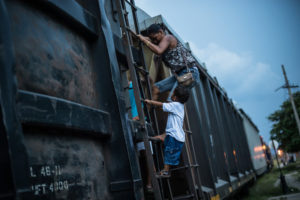
Photo Credit: NY Times. Young children often travel through Central America and Mexico by riding on top of freight trains, risking life-threatening injuries and death.
Along the route, there are thousands of other children who are also seeking refuge. They stick together and many kind souls along the way provide them with hot meals and the occasional hot shower or floor mat to rest. Eventually the long journey comes to an end. Some do not make it. Others tell vivid stories of crossing the Rio Grande with US Border Patrol officials looking on with their hands crossed in front of their chest as the child gasps for air and flaps his arms high above his head. He cannot swim. But for those who make it, there awaits an entirely new journey on the other side.
The Border Crossing
Unaccompanied refugee children and children arriving with their families are processed under two different jurisdictions of the US government upon entering the country. The children coming alone are sent to a “casa hogar,” or an immigration center for children run by the Department of Health and Human Services, until they can be united with their parent or guardian in the United States. Families entering together are held in family detention centers run by the Department of Homeland Security. Both pathways begin in “la hielera,” or ice box. These cold, warehouse-like facilities house children and families in cages resembling those used as kennels for dogs. They are given a floor mat and a silver blanket like those used by marathon runners. This terrifying experience of being caged up is what sticks with many children as one of the most traumatic events during their long journey of escaping terrible conditions. Like our patient in clinic this week, this vivid memory haunts many children for weeks, months and years to come.
Reunification
Many of our patients tell harrowing stories of their journey to refuge. The long trip north, followed by often a day or two in the “hielera” and then up to 30 to 60 days in the “casa hogar” centers before being released to their families is exhausting. The majority of our patients are reunited with biological parents who fled their countries 5, 7, or 10 years prior and worked tirelessly to bring their children over to safety. The child enters a household full of biological relatives who he has never known, or who he last saw when he was a toddler. In many cases, the child meets new siblings and has to start yet another journey of discovering his role within his own family. The stress of starting a new school in a new language in a new country and in a new family is immense. While the focus on guiding this child’s adjustment takes priority, it is often easy to forget that the trauma and violent past exposures still lay deep within him. The pending court date as the child awaits his asylum hearing adds yet another layer of emotional stress.
Our Role as Pediatricians: the Medical Home
We are in constant admiration of the refugee children and their families who come to our clinic. We know the journey they took to get to our clinic door was not an easy one, nor is it one easily spoken about. Our team has made it our mission and responsibility to create the highest quality medical home possible for immigrant and refugee children in the New Orleans area. We have the upmost respect for the complexity and compassion with which the delicate experiences of these children must be handled. We work through partnerships in the community to create a referral network to help meet the many needs of these children. We treat not only their medical conditions in our primary care clinics, but we also address their social, educational, emotional and legal needs by connecting them to other vital services in the community.
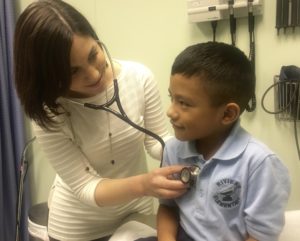
Dr. Kim Mukerjee is seen here with another young patient who came to clinic for his preventive check-up. Dr. Mukerjee is the director of Immigrant and Refugee Health for the New Orleans Children’s Health Project and the Tulane section of Community Pediatrics.
Our approach has been to standardize care for immigrant and refugee children by designing and following a clinical template for every intake of new patients. All visits are completed in Spanish by our bilingual team of physicians or with the assistance of an interpreter. We invest critical time in having families complete lengthy but important developmental screening questionnaires for each child. Many of the children we see have never seen a pediatrician previously. They often have undiagnosed chronic medical conditions or delayed growth and development that has gone undetected. We complete a thorough intake that includes detailed immigration histories, past medical history and a complete social history so that we can understand as much as possible about what the child has experienced and how we can best develop a plan of care going forward.
Our approach is always through a trauma-focused lens. We screen for post-traumatic stress disorder, depression and anxiety in our patients because of the high likelihood that the child is experiencing emotional distress. We screen for vision and hearing abnormalities, common childhood conditions such as asthma, and we screen our families for food insecurity and nutritional needs. We know that in order to have the best possible chance of thriving in school and adjusting to his or her new life here, we must thoroughly assess these many areas that can lead to poor health outcomes and difficulty in school if left unaddressed.
The team approach: Case Managers
Our work cannot be done without the vital work of our case manager, Miguel Alonso. Miguel was trained and inspired by our dear late case manager, Carlos Naranjo who we lost recently to illness. Their role on our team is crucial. Through case managers, we have worked to break down many of the known barriers that prevent immigrant families from accessing healthcare for their children. These include language barriers, lack of health insurance, concerns over immigration/legal matters, lack of personal IDs and financial limitations. It is our case manager who answers our phones, helps patients schedule appointments, explains the clinic’s sliding scale policies and informs families that we see all patients regardless of insurance status and certainly regardless of their immigration status. Families have learned to trust our team due to this immense rapport and feeling of security they have built with our case managers.
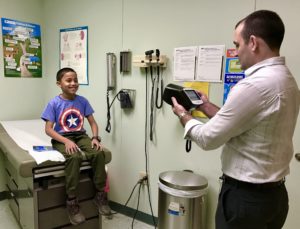
Miguel Alonso, case manager for the New Orleans Children’s Health Project, screens every patient for vision abnormalities using a Spot Vision scanner. He also checks for hearing abnormalities and hands out all of the developmental screening forms to each patient at the beginning of the clinic visit.
Our refugee patients are not eligible for Medicaid health insurance coverage in the state of Louisiana. We partner with a local federally qualified health care center in order to see these children on a sliding scale fee system to provide primary care services. At one of our clinical sites, over 80% of our patient visits last year were with uninsured patients. We take our role of providing care to children who otherwise have no where else to go to receive such thorough care very seriously. When we detect a condition that requires the assistance of a sub-specialist, our case manager helps each family apply for a possible financial assistance program through the local Children’s Hospital. However, the requirements for this program have become increasingly challenging for families to meet and the time required by our case manager to assist them has tripled. While some children are fortunate to get sub-specialty care, the majority are left in a stage of limbo since they cannot meet the high demands of the application process and most simply never gain access to these services.
Never give up
As a team, we fight battles every single day for our patients. We fight for insurance coverage when they need specialty care. We have partnered with a local foundation to cover the cost of eye and hearing exams. We reach out to teachers and attorneys to discuss concerns and link the child to services. We search for bilingual mental health providers when there are far too few to meet the needs of our patients. But mostly, we advocate for our patients to grow up as healthy children with access to all basic human rights: a safe and loving home environment, sufficient food, access to education, healthcare and the right to safety. These are children who are fleeing unspeakable conditions that we cannot begin to imagine. We feel honored to play such an intricate role in their lives and to be part of the next phase of their journey.
Written by Kim Mukerjee, MD
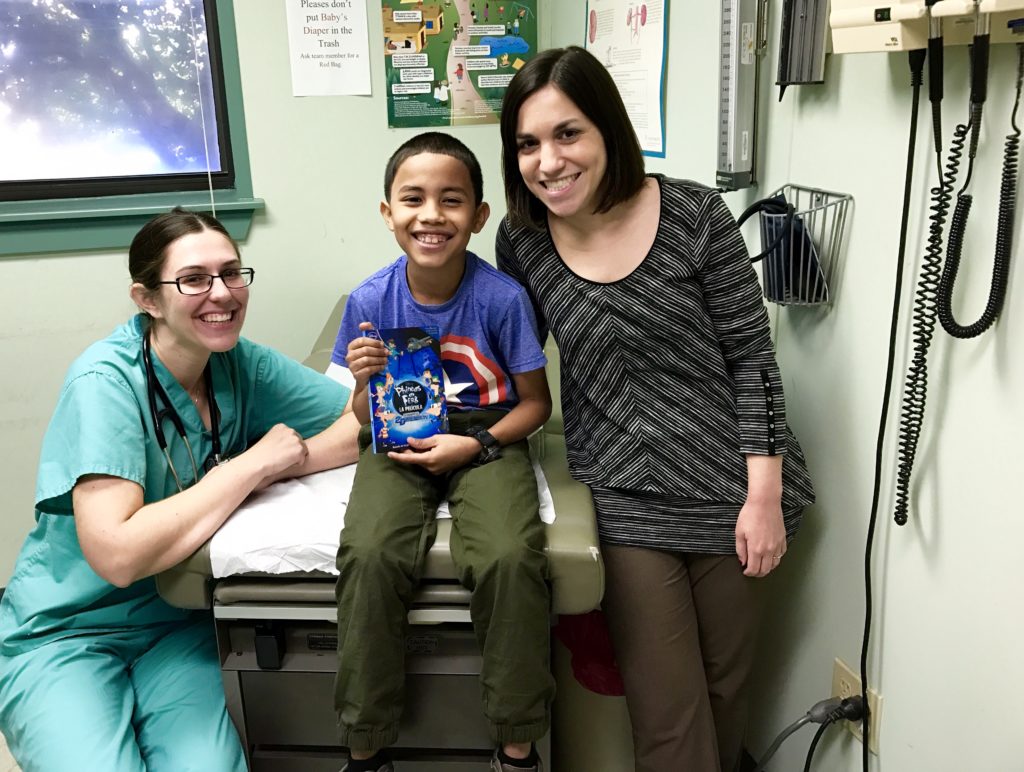
Dr. Dietrich and Dr. Mukerjee with one of our patients who is happily showing off the book he just received in clinic!

